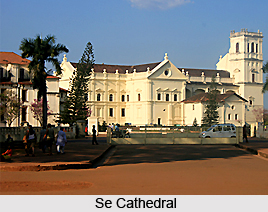 The religious monuments of Goa are primarily places of Christian worship due to the long-held dominance of the Portuguese colonial powers here. Once the capital of the Portuguese settlement, the town on the banks of the Mandovi River is often called Old Goa or Goa Velha to distinguish it from the new Capital of Panaji (called new Goa). A number of Churches and convents are found in Goa, a heritage left behind by the Portuguese settlers.
The religious monuments of Goa are primarily places of Christian worship due to the long-held dominance of the Portuguese colonial powers here. Once the capital of the Portuguese settlement, the town on the banks of the Mandovi River is often called Old Goa or Goa Velha to distinguish it from the new Capital of Panaji (called new Goa). A number of Churches and convents are found in Goa, a heritage left behind by the Portuguese settlers.
Among the biggest Churches in Goa is the Se Cathedral or Cathedral of St Catherine. It is also the largest Christian church in Asia. Commenced in 1562, the main body of the building was completed by 1619, but it was not until 1652 that the altars were finished. The Church is 250 feet long, 180 feet wide and the facade is 116 ft high. The cathedral was built for the Dominicans from the proceeds of a sale of Crown property.
European Renaissance architecture is given wide display in the construction of the Cathedral. The principal facade faces east. There are three porticos and three naves. In the centre of the middle portico is an inscribed memorial slab carrying the papal insignia. Externally, it is designed in a Tuscan Ionic style; internally, it is Corinthian. Originally, there were two towers, but the southern tower collapsed in 1776. The remaining tower houses the Golden Bell; cast at Candolim in 1652.The Church has a stunning interior. It is divided by two rows of massive pillars into a nave and two large side aisles. The ceiling is vaulted. To the right of the entrance is an octagonal baptismal font made of a single block of granite. Here St Francis Xavier is reported to have baptized hundreds of followers in 1542. To the left lies a large painting of St Christopher carrying the Infant Jesus. Turning right there are four chapels: to St. Anthony, St Bernard, the Cross of Miracles and the Holy Spirit. The cross in the third chapel is alleged to grow in size.
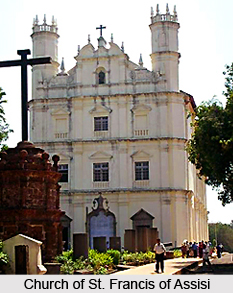 The Church of St Francis of Assisi is attached to the Convent of St Francis of Assisi. It is one of the most interesting buildings in Goa. A church was built here in 1521. It is a marvellous repository of ecclesiastical art of the period. Externally, it is Tuscan in style. In a niche on the facade is a statue of St Michael. The church faces west, with a central nave and three altars or chapels on each side and a choir and two altars in the transept beside the High Altar. The nave is rib-vaulted. The internal walls separating the chapels have frescoes of elaborate floral patterns in Indian style. Over the tabernacle in the High Altar is a large statue of St Francis of Assisi and another of Christ Crucified. Flanking the altar are paintings on wood depicting scenes from the life of St Francis. The floor is paved with carved tombstones.
The Church of St Francis of Assisi is attached to the Convent of St Francis of Assisi. It is one of the most interesting buildings in Goa. A church was built here in 1521. It is a marvellous repository of ecclesiastical art of the period. Externally, it is Tuscan in style. In a niche on the facade is a statue of St Michael. The church faces west, with a central nave and three altars or chapels on each side and a choir and two altars in the transept beside the High Altar. The nave is rib-vaulted. The internal walls separating the chapels have frescoes of elaborate floral patterns in Indian style. Over the tabernacle in the High Altar is a large statue of St Francis of Assisi and another of Christ Crucified. Flanking the altar are paintings on wood depicting scenes from the life of St Francis. The floor is paved with carved tombstones.
One of the most famous religious monuments of Goa is the huge Basilica of Bom Jesus, facing a large central square, more popularly known as the Church of St Francis Xavier. Literally translated to Good Jesus, the Bom Jesus Basilica was erected in 1594 and consecrated in 1605. It is a Renaissance Baroque building combining Ionic, Doric, Corinthian and composite styles in an imaginative and original manner. Its principal facade faces west. Crowning the stone facade are the letters IHS: `Iaeus Hominum Satuator.` The church is cruciform in plan, supported by three buttresses on the northern side. Built of laterite, the exterior is divided into four stages. The lowest has three elegant entrances, above which arc three large windows, then three circular windows culminating in a richly carved central gable with arabesques. The bell tower is at the rear.
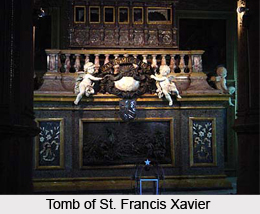 The interior of the church is plainly detailed in a Corinthian style. On each side are three bays of windows rising above each other. Note the plaques on the columns supporting the choir; they record the construction of the church in Latin and Portuguese. In the centre of the nave is the cenotaph of the benefactor of the church, Don Jeronimo Mascarenhas, who died in 1593. It is a splendidly elaborate affair in richly gilded bronze, carried on two lions. The wooden pulpit is also lavishly carved with figures of Jesus Christ, the Evangelists and the four doctors of the church. Around the base are seven figures. In the transept on the north side is the chapel of the Blessed Sacrament.
To the South of the transept lies the Chapel and Tomb of St Francis Xavier. St Francis Xavier had a considerable role in the spreading of missionary doctrine in India. He spent a lot of his time here nursing the sick, baptizing the Christians of India and spreading the gospel. After his death in 1552, his body was placed in the Basilica and he was canonized a saint.
The interior of the church is plainly detailed in a Corinthian style. On each side are three bays of windows rising above each other. Note the plaques on the columns supporting the choir; they record the construction of the church in Latin and Portuguese. In the centre of the nave is the cenotaph of the benefactor of the church, Don Jeronimo Mascarenhas, who died in 1593. It is a splendidly elaborate affair in richly gilded bronze, carried on two lions. The wooden pulpit is also lavishly carved with figures of Jesus Christ, the Evangelists and the four doctors of the church. Around the base are seven figures. In the transept on the north side is the chapel of the Blessed Sacrament.
To the South of the transept lies the Chapel and Tomb of St Francis Xavier. St Francis Xavier had a considerable role in the spreading of missionary doctrine in India. He spent a lot of his time here nursing the sick, baptizing the Christians of India and spreading the gospel. After his death in 1552, his body was placed in the Basilica and he was canonized a saint.
The tomb of St Francis Xavier is a beautiful affair gifted by the Grand Duke Cosmos III of Tuscany. It took the sculptor Givonni Batista Foggini ten years to complete the building of this tomb and it was finally placed in 1698. The tomb is a spectacular specimen of Italian and Indian art. It consists of three tiers of sarcophagi in jasper and marble, the base, the mausoleum and the casket. On the middle section are bronze plaques depicting scenes from his life and work. There are two cherubs of Carrara alabaster in each corner. The silver casket is a reliquary containing the sacred remains of the saint. The casket is divided on each side into seven panels. There is a cross on top with two angels. In front of the casket is a fine silver statue of the saint.
The interior of the Chapel of St Francis Xavier is richly ornamented with carved detail and paintings illustrating scenes from the life of St Francis. One of the paintings in the top row shows his death at Sancian. The corridor from the chapel to the sacristy is decorated with nine beautiful paintings. The entrance to the vaulted sacristy is via a splendid door carved in relief with the figures of four saints. Every ten years the holy relics are displayed to the public on the anniversary of the saint`s death. There is a modern art gallery next to the church.
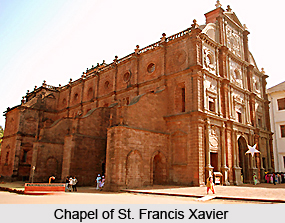 The Chapel of St Catherine was constructed in 1510 by Albuquerque to celebrate his conquest of Goa. In 1550 it was enlarged by Jorge Cabral, the Governor. The facade, in Renaissance style, carries a statue of Our Lady. There is a statue of Our Lady of Piety over the altar.
The Chapel of St Catherine was constructed in 1510 by Albuquerque to celebrate his conquest of Goa. In 1550 it was enlarged by Jorge Cabral, the Governor. The facade, in Renaissance style, carries a statue of Our Lady. There is a statue of Our Lady of Piety over the altar.
The Convent and Church of St Cajetan is situated opposite the Se Cathedral. Dedicated to Our Lady of Divine Providence, it was built by Italian friars of the Theatine Order, who were sent to India by Pope Urban III to preach Christianity in the kingdom of Golconda. The Convent was built in 1649 and the Church in 1651. The church is architecturally designed along the lines of the St Peter`s in Rome. It has a Corinthian order externally and internally. It is crowned by a dome and two low towers. Faced in plastered laterite, the church is vaulted and designed on the plan of a Greek Cross. The nave terminates in an apse and aisles marked by four massive piers faced with Corinthian pilasters which carry the base of the drum of the dome. On the threshold is inscribed in bold letters `Domus mea Domus Orationis`: `My House is a House of Prayer.`
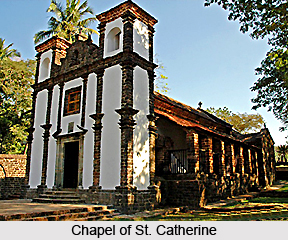 Inside are three chapels to the left and three to the right. The main altar in the sanctuary is profusely carved and gilded. The altars in the chapels are treated in a similar manner. Of particular note is the elaborate pulpit with the carved figures of a bull, an eagle, an angel and a lion. In the crossing is a square platform beneath which is a well.
Inside are three chapels to the left and three to the right. The main altar in the sanctuary is profusely carved and gilded. The altars in the chapels are treated in a similar manner. Of particular note is the elaborate pulpit with the carved figures of a bull, an eagle, an angel and a lion. In the crossing is a square platform beneath which is a well.
Four chapels - Nossa Senhora de Necessidades, St Sebastian, the Blessed Sacrament and Nossa Senhora de Boa Vida - are found to the left of the Palacio de Fortaleza in Goa. The Chapel of the Blessed Sacrament has a beautiful decorated altar. Beyond, in the transept, are six altars. In the vestry are pictures of St Catherine and the Twelve Apostles. The High Altar terminates the vista down the nave with an elaborately carved and gilded altarpiece, richly adorned with pillars, pilasters and engravings. It has three niches in the centre, one above the other, containing images of St Catherine and Christ Crucified. On either side of the altarpiece are the images of St. Peter and St. Paul and four engravings depicting the martyrdom of St. Catherine.
The Chapel of Our Lady of the Rosary is located at the summit of Holy Hill. The chapel was built in 1526 and belongs to the earliest Manueline period of church architecture in Goa. Built of laterite and faced in Ionic plasterwork, it has a two-storey portico, a single tower and cylindrical turrets each side of the facade. Also seen are Bijapur-style carved designs in the stonework of the tomb to the right of the main altar. It was from here Albuquerque directed the battle against the troops of the Adil Shahi dynasty of Bijapur in 1510.
The Church and Convent of St Monica is the oldest and biggest in eastern Asia. It was completed in 1627 as a retreat for cloistered nuns. Externally, it is designed in a free combination of Tuscan, Corinthian and composite styles. Inside it is Doric and composite. Over the entrance to the convent is a coat of arms.
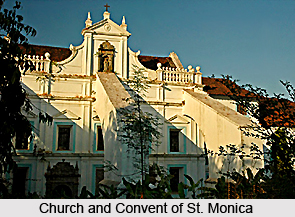 The Convent of St John of God was founded in 1685 by the Order of Hospitallers of St John of God to care for the sick. The church was commenced in 1691 and completed in 1721. The Convent was rebuilt in 1953.
The Convent of St John of God was founded in 1685 by the Order of Hospitallers of St John of God to care for the sick. The church was commenced in 1691 and completed in 1721. The Convent was rebuilt in 1953.
The Chapel of St Anthony, the national saint of Portugal was built in 1543. It has a vaulted chancel with four frescoes on the walls. It closed in 1835, reopened in 1894 and was restored by the Portuguese government in 1961.
The Professed House of the Jesuits is a majestic, two-storey laterite building covered in plaster and connected to the Basilica. Built in 1589, it is from here that the devoted Jesuit missionaries travelled throughout the East. It was damaged by fire in 1663 and extensively reconstructed in 1783. Today it is used as priests` quarters.
The tower of the Church of St Augustine is situated on the Holy Hill. The church and former convent were erected in 1512 and reconstructed in 1597 and 1602. Designed in a Gothic style, the church once boasted eight richly adorned chapels and two high towers. The vault collapsed in 1842, burying a colossal image of St Augustine. In 1931 the facade and main tower fell. It is now in ruins.
The Church of the Cross of Miracles used to lie on the southern perimeter of the city. It was built by the Carmelites in 1619 and rebuilt in 1674. Only the facade remains.
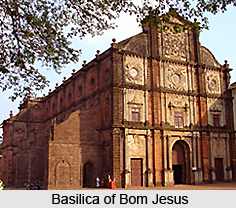 On the hill opposite the Basilica of Bom Jesus, en route to the Church of Our Lady of the Rosary, is a vast three-storey building of laterite, square in plan but with a large inner courtyard surrounded by a cloister, cells and halls. There is a vaulted ceiling and painted ornament illustrating scenes from the Bible.
On the hill opposite the Basilica of Bom Jesus, en route to the Church of Our Lady of the Rosary, is a vast three-storey building of laterite, square in plan but with a large inner courtyard surrounded by a cloister, cells and halls. There is a vaulted ceiling and painted ornament illustrating scenes from the Bible.
Ancient sites of Hindu worship, temples, are also to be found in Goa. Though mostly destroyed, a few are worth mentioning as monuments.
Site of the temple of Saptakoteshwar
Originally, the Kadamba Kings of Goa had built this temple at Diwadi in the early part of the twelfth century. It is believed that the ancient rulers of Goa, the Hindu Kadamba dynasty, worshipped this incarnation of Lord Shiva known as Saptakoteshwar. Subsequently this temple went through a number of demolitions- in the fourteenth century by the Sultans of the Deccan, and though later rebuilt by the Vijayanagara Empire, again destroyed in 1540 by the Portuguese. The temple was later shifted to its present site at Narva in Bicholim by the local chieftain of Bicholim.
Ruins of the Temple of Brahmapur at Ela village, Old Goa
At Ela village was a colony of Brahmins, founded by Madhava Mantri that reportedly existed since ancient times. The temple of Lord Goveshwar, another name for Lord Shiva, was venerated here. However this temple too was destroyed by the Portuguese, along with several other Hindu temples, when they conquered Goa.
Islamic influences too can be seen in the form of the mosques built here.
The Safa Masjid was built by Ibrahim Adil Shah of Bijapur. It has a pointed roof, made out of terracotta tiles. Islamic arches cover the walls. Beside the mosque is a masonry tank which has small chambers with mehrab designs. The mosque was extremely beautiful when it was created, surrounded by fountains and gardens. These gardens and fountains of the mosque were destroyed during Portuguese invasion.
The Namazgah was built by Emperor Akbar of the Mughal dynasty. Contained here is the tomb of Hazrat Abdullah Khan Shahid. It is over this tomb that the Maratha King Sambhaji had prayed for victory over the Portuguese and announced a grant for its keep. This was fulfilled later by Akbar. The Namazgah is situated on the picturesque hill of Bicholim.
Thus, lie strewn all over Goa the various monuments of religious worship. Though the remains of a few temples and mosques are also to be found here, the chief religious monuments are Churches, an outcome of the Portuguese domination of Goa.



















